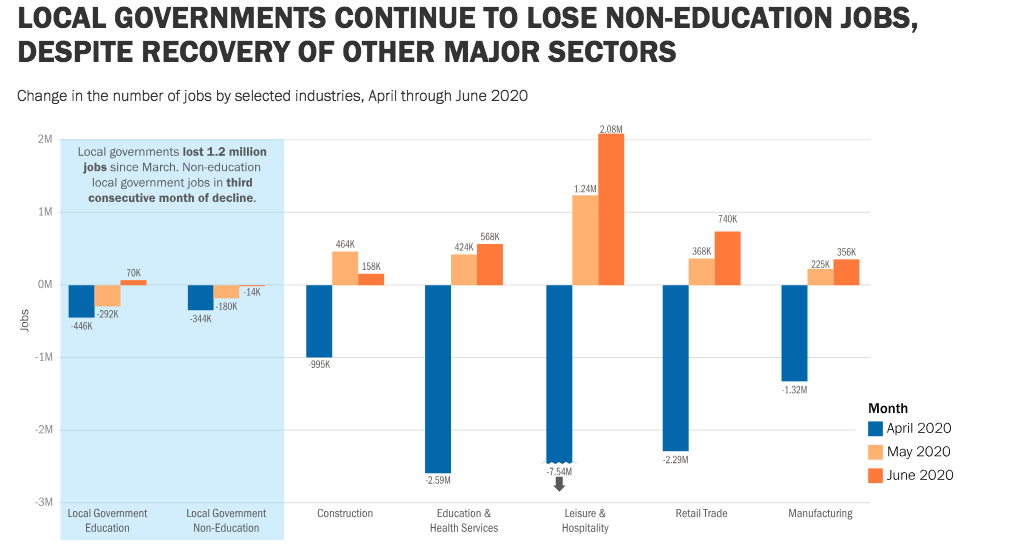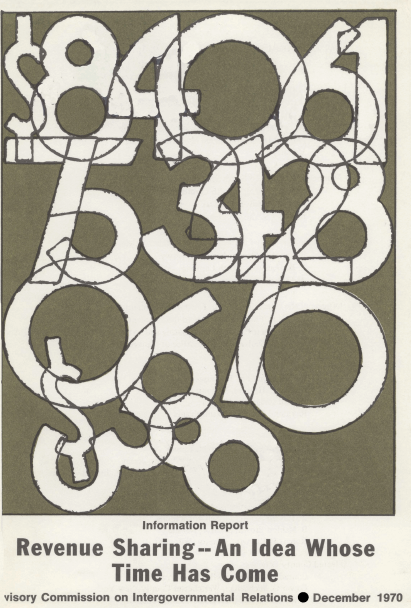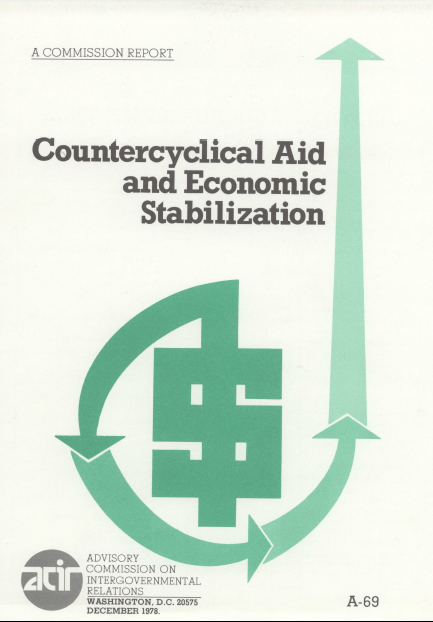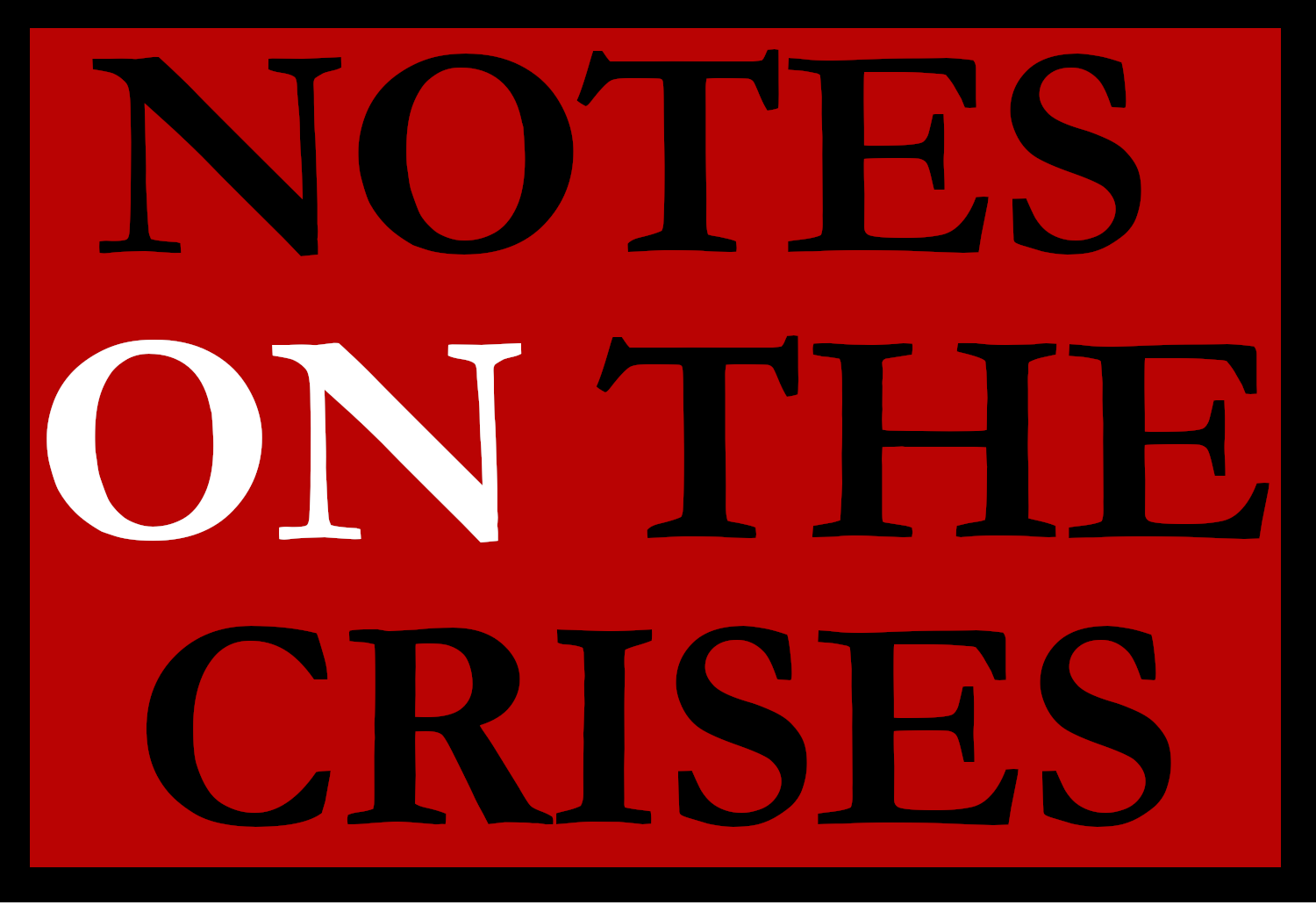State and Local Austerity is a Death Trap – Rip it Up and Start Again.
Toward an Alternative Fiscal Federalism [Guest Post by Philip Rocco]

This is a Guest Article for Notes on the Crises. Thanks to the generous support of our paid subscribers, we can now afford to have guest writers. If you would like to support expanding the activities of Notes on the Crises, click here.
Philip Rocco is an assistant professor of political science at Marquette University and co-author of Obamacare Wars: Federalism, State Politics, and the Affordable Care Act.
A student should enter the field of intergovernmental fiscal relations with modesty and even humility…It is a field mined with explosives; beneath a placid surface lie some very deep emotions ready to burst into flame at the slightest provocation.
Committee on Intergovernmental Fiscal Relations, U.S. Treasury Department (1943)
This past Sunday, Maryland governor Larry Hogan appeared on NBC’s Meet the Press. For a brief few minutes, he calmly responded to questions — about school reopenings, his meetings with the Vice President, his recent book, and his thoughts on the future of the Republican Party.
The conversation was, in a word, uneventful. It would not be worth describing at all, in fact, but for a curious omission: State and local governments are on the precipice of an historic fiscal crisis. Their revenues are projected to decline collectively by more than $1 trillion dollars over the next three years. Yet neither this fact, nor inaction by Congress and the Fed — nor Hogan’s thoughts on any of this in his role as leader of the National Governors Association — earned so much as a word from host Chuck Todd. This silence seems all the more ominous as states around the country began a harsh new round of austerity in response to the Coronavirus crisis. This has included cutting vital public services (including mental health), furloughing millions of employees, and deferring repairs to critical infrastructure.
One may be forgiven for failing to notice omissions that come into view only once the rest of the facts have been assembled. The wretched state of US intergovernmental finance may be public knowledge of a sort, but it is far better described as an open secret. State-local finances are rarely viewed as integral to the discussion of any issue, even — and perhaps especially — pandemic response. Discussion about closing down bars and restaurants floats towards comparing the public stances of the major parties, business associations, and perhaps voters. The effect of massive layoffs on income-tax revenue, by contrast, is likely to remain submerged.
This is not only a failing of the media. In the recently published report of the Biden-Sanders ‘Unity Task Forces’, one can find barely a passing mention of state and local finances — even when discussing proposals to expand health-insurance coverage. Almost undetectable in this document is the sheer magnitude of states’ Medicaid spending. Or the singularly contemptible likelihood that states will cut this spending in the midst of a pandemic.

Yet such oversights cannot be charged to task-force personnel, or the producers of Meet the Press. They are, in fact, entirely normal in a polity with nationalized politics, but decentralized revenues.
Federalism defines much political conflict in the United States. But it rarely attracts policymakers’ interest as a subject for reform in its own right. This is not the case in all federations; fiscal federalism has recently been a live political issue in Canada and Australia. Nor has it always been the case here. At various moments between the 1960s and the 1990s, intergovernmental fiscal relations were towards the top of the national agenda. In the summer of 1967 — in the midst of widespread urban civil unrest — Congress’s Joint Economic Committee held hearings that explicitly recognized that the “crisis of the cities” was equally fiscal, and political.
Nor can federalism’s absence from the debate be attributed to the “eyes glaze over” effect that may seem endemic to the topic. Few policy issues are really organically boring. They are made so when institutions fail to translate their occult features into public prose, linking policy choices to life-and-death consequences, or broadly popular demands. Or when the institutions that perform this work are eviscerated.
Hardly a sentence can be written about the management of this pandemic that does not in some way implicate the revenue conditions of states, cities, counties, towns, and villages. As I and others have argued, the dire fiscal situation — and Congress’s failure to respond — has pushed states to reopen their economies too soon. The status quo promises only more death, despair, and disease.
Yet in debating a post-pandemic society, federalism is treated as incidental to the outcomes, reduced to a dysfunction that would ideally not exist in a democratic society, or alternatively glorified as a structure that “provides flexibility and the ability to tailor [policy] responses to the [local] context.”
The American federal system is ultimately none of these things, nor is it — strictly speaking — a system at all. American federalism is instead a relatively taken-for-granted concept of the mind. A principle whose current realization nevertheless leaves us with a crisis, and one that currently undermines the most basic of public services.
A Field Mined with Explosives
While much has been made of increasingly grim state revenue projections, economic shutdowns from COVID-19 have already taken a toll on most categories of state revenue — from state lotteries to the gas tax. States that rely heavily on revenue from tourism have also been severely impacted.
The pandemic has had an especially acute effect on state revenue from the income tax. Between April and June, the net impact on individual income tax collections is projected to be $83 billion. As Ronald Alt notes, we will likely see an increase in income-tax payments in July as payments originally due in April are made. Nevertheless, returns will still be significantly diminished for the first two quarters. These revenue shortfalls occur in the midst of rising demand for public services — from Medicaid to Unemployment Insurance — which rely extensively on states’ own-source revenues.
Subnational revenue shortfalls need not constitute a crisis. Consider Canada, where provinces are responsible for a large share of major open-ended expenditures (primarily for universal health care). Like US states and cities, Canadian provinces have highly cyclical revenue streams. Yet unlike their US counterparts, which face tight balanced-budget requirements and cautious credit markets, the provinces can borrow without restriction at low interest rates. During the pandemic, the Bank of Canada announced that it would buy up to 40 percent of each province’s short-term debt offering, and up to $50 billion of bonds with a maturity of 10 years or less. While more dramatic reforms of Canadian fiscal transfer programs may be in the offing long-term, these existing measures have enabled provinces to weather COVID-19 far better than the American states. Between June 2019 and June 2020, public employment in the US has declined at roughly twice the rate of Canada. The US dropoff is driven entirely by state and local employment (by contrast, federal employment increased over the same period).

Beset by fiscal restrictions, state and local governments have essentially staked their future on the federal government’s extensive counter-cyclical capacity. Viewed fiscally, the current crisis is the federal government’s failure to leverage that capacity to preserve the integrity of subnational governments. While the state-and-local revenue shortfall is collectively projected to be about $1 trillion, the CARES Act provided states with only $150 billion for emergency Coronavirus spending, yet it did not allow states or cities to use this money to make up for lost revenue. Of the 225 governmental entities eligible for the Federal Reserve’s Municipal Liquidity Facility, 97% are functionally excluded due to costly and restrictive loan terms. Thus far only one state government and no local governments have used the facility.
It is tempting to attribute these inadequate responses to partisan polarization. In May, Senate Republicans killed consideration of the HEROES Act — which included more than $1 trillion in additional state-local revenue support. Yet the roots of the problem lie not in partisan disagreement, but in the necessity of reaching such agreements in the first place.
Anti-recession policy in the United States tends to be discretionary, rather than automatic. Even when so-called ‘automatic stabilizers’ such as Unemployment Insurance and Medicaid ‘switch on’ during recessions, they usually require some form of discretionary expansion or recalibration.
During a crisis, policymakers must work on a relatively quick timeline to enact policies they believe will have the magnitude and duration appropriate to match the scale of the economic decline. In response to the 2008 Recession, Congress adopted a patchwork of emergency programs. The American Recovery and Reinvestment Act devoted a roughly even share of outlays to tax cuts, expansions to programs such as Medicaid and unemployment benefits, and discretionary spending (including direct assistance to individuals and support for infrastructure programs.) Between 2009 and 2012, Congress expanded its patchwork of relief programs, with the largest shares of fiscal support devoted to a payroll tax cut, and extensions to unemployment insurance. Yet despite the persistence of high unemployment, federal fiscal policy turned contractionary between 2011 and 2014 as emergency policies expired. This represented a major departure from prior economic recoveries.
In the wake of COVID-19, neither Republicans nor Democrats proposed any new automatic stabilizers for state and local revenues pegged to the unemployment rate. Political scientists’ explanation for this outcome hinges not on polarization, but the venerable theory of “credit claiming.” In other words: if benefits are created automatically, members of Congress lose the opportunity to claim credit, and build an electoral connection with their constituents. Yet this argument cannot account for two important facts. First, proposals for automatic intergovernmental stabilizers were arguably far more popular in the “Textbook Congress” of the 1970s, the period which the credit-claiming theory should describe best. Second, during COVID-19 pandemic, none of the “Big 7” intergovernmental organizations even demanded automatic stabilizers. Rather, these policy proposals have remained the domain of think-tank economists rather than organized interests. What happened?
Non-System Federalism
The answer to this question rests in part on the absence of formalized intergovernmental relations in the United States. While the US is comparable to other federations in terms of fiscal decentralization, it lacks institutions like the German Bundesrat, or Canadian First Ministers’ conferences. These bodies allow for formal representation and bargaining between subnational and central governments. Rather, state and local governments — however vital their services and their contributions to the national economy — lobby for attention on a terrain crowded with an increasing number of powerful stakeholders. In the first quarter of 2020, lobbying expenditures by the pharmaceutical industry were five times higher than those of civil servants, and public officials. For their part, national associations of state and local officials did make a vigorous push for federal relief in the weeks following the COVID-19 emergency declaration. Yet they did not always act in concert with one another.
Moreover, individual associations did not release major requests for general relief until after the first major spike in unemployment claims. At the time of the CARES Act’s passage, only five states had even revised revenue projections for Fiscal Year 2021 in light of the pandemic.
This apparent ineptitude is really the result of a breakdown in public bodies established across the mid-20th century. Prior to the emergence of the fiscal austerity regime in the late 1970s, the makings of a more systematic federalism — a federal system worthy of the name — were easier to find. In 1959, Congress created the Advisory Commission on Intergovernmental Relations (ACIR) — a unique body made up of representatives from each level of government — which aggressively promoted the idea that federalism could be managed comprehensively. Borrowing ideas from domestic and international sources, the ACIR advocated routine, formal interaction between levels of government. It began efforts to map the intergovernmental effects of legislation, and policies that — almost hydraulically — compensated for gaps in institutional capacity.
The Commission had the effect of redefining, for a time, the concepts by which policymakers understood the reality of fiscal federalism. The collation of decentralized statistical data on fiscal and administrative relationships allowed policymakers to observe directly the consequences of haphazard policy development. The ACIR also performed what sociologists of science call ‘boundary work’. Transforming the opinions of state and local officials’ into official statistics which reframed self-interested arguments as neutral claims about good governance. This is how policymakers came to see federalism not as a static constitutional arrangement, but as a dynamic set of “intergovernmental relations”, that could be managed via public policy.
One can locate the influence of the ACIR in the enactment of policies like General Revenue Sharing — the only truly open-ended fiscal transfer program the federal government has ever adopted. To be sure, the Commission was not the first organization to propose federal revenue sharing. Prior to the 1964 election, economists working for both Lyndon Johnson and Barry Goldwater seeded the same idea — though for very different purposes.
Yet what set the ACIR’s idea apart from these earlier plans was that it explicitly treated revenue sharing as a solution to the urban crisis. It did so in a prodigious, two-volume study, Fiscal Balance in the American Federal System, which argued explicitly that the chaotic system of intergovernmental relations was contributing to the most important domestic policy issue of the day: the crisis of poverty and social unrest in large cities. Whereas other presidential task forces had treated these problems sociologically, the ACIR framed them in terms of fiscal and administrative machinery. To solve the “crisis of the cities,” Fiscal Balance offered a package of hundreds of recommendations, the bulk of which focused on the federal grant-in-aid system itself. Enabling states and cities to better “solve their own problems”, the report suggested, meant providing them with general revenue-sharing payments based on population and tax effort.
Not only did this reframing of the issue place General Revenue Sharing on the map as a serious policy pledge — ultimately embraced by members of both parties — it enabled the ACIR to become an authoritative voice on revenue sharing. When the Nixon campaign’s task force on intergovernmental fiscal relations began assembling policy proposals prior to the 1968 election, Fiscal Balance was its primary source. After the enactment of General Revenue Sharing in 1972, the ACIR became not only one of the law’s most outspoken defenders, but also a major proponent of an automatic intergovernmental stabilizer program. This proposal would send state and local governments automatic payments pegged to unemployment conditions. The federal government, the Commission argued, had an important role to play in antirecession activity — especially given the massive contributions of state and local spending to GDP. Yet in the absence of an automatic program, Washington could not be relied on to deliver timely support to the states.

These expansionary visions of fiscal federalism fell victim to a changing political economy. Combined with the Federal Reserve’s 1979 credit crunch, the Reagan administration’s program of “New Federalism” further decentralized the economy, forcing states to compete more intensely for capital investment,. This allowed businesses to reset the terms of class compromise. Further, measures limiting the growth of the local property-tax levy, which emerged with increasing rapidity in the late 1970s, ultimately constrained spending in the local public sector. This had significant implications for the quality of education, public health, and social services. As state governments began to take on an increasing array of policy responsibilities, they continued to rely overwhelmingly on their own revenue, rather than federal transfers as a source of financing.

By 1986, austerity politics would eliminate General Revenue Sharing, foreclosing anything like an automatic system of shock absorbers for federalism. Indeed, during the Reagan administration, federalism became a synonym for deregulation and retrenchment of social programs. The ACIR, like other knowledge-producing entities, was gradually starved for resources, relocated, and downsized. Its colorfully designed reports were phased out. Print-runs fell sharply. Finally, in 1996, a Republican Congress zeroed out its budget. Fiscal crises loomed, but the makings of a ‘systemic’ federalism had all but disappeared.
Reconstructing the Federal Bargain
The demise of the ACIR — and the disappearance of some of its more fiscally expansionary ideas — can help us understand where we find ourselves today. This relatively obscure advisory body was effectively the only site in which formal intergovernmental policy negotiations could take place. Uniquely, the ACIR had reframed state and local officials not as mere claimants on the federal government, but as the constituent parts of a federal system. This is not the case now. The White House of Office of Intergovernmental Affairs exists primarily to manage the President’s political reputation, not as a venue for brokerage. When Larry Hogan and the governors are invited to the White House, they are advised more than they advise. Automatic stabilizers are not on the table, perhaps not even on the menu. And the effects of any of these decisions, or non-decisions, will be buried far from public view – until their ugliest effects are upon us. A revived ACIR would be no substitute for fiscal policies that meet the scale of this moment. But it would help to cue public attention to the costs of doing nothing.
In any case, it may take a sustained measure of ugliness before anything changes — austerity of a sort seen only in present-day Puerto Rico or late-1970s New York. But even then, our sclerotic political institutions will remain a hazard. The relatively nationalized party system — and the hollowness of state and local party organizations — have a way of preemptively preventing what Canada’s decentralized party system permits. The malapportioned Senate makes a Rubik’s cube of any effort to achieve state fiscal equalization. And presidential federalism initiatives have the tendency to be one-off, personalistic affairs rather than enduring commitments.
Most importantly, past efforts to mediate ‘grand bargains’ to sort out federal and state fiscal responsibilities have consistently failed to gain traction. These bargains have failed not merely because of a lack of presidential commitment, but because they have never tied fiscal reorganization to policies that address broadly popular demands. To the contrary, both Dwight Eisenhower’s Joint Federal-State Action Committee and Ronald Reagan’s Presidential Advisory Committee on Federalism aimed to sort out federal functions in the service of fiscal retrenchment – hardly a majoritarian project.
In recent years, progressives like Heather Gerken have attempted to reclaim the mantle of federalism from the right, but they have erred by focusing almost exclusively on how a smattering of blue states can resist national policies and generate incremental policy innovations. These proposals fail to consider how present fiscal structures are biased towards austerity. By contrast, the COVID-19 pandemic and the economic crisis it has spawned present a rare opportunity to reconstruct the terms of fiscal federalism. Not through an obscure program of equalization or ‘sorting out’, but through addressing popular demands. This will allow for fundamental deficiencies in state revenue structures, in ways that leave ample opportunity for political credit claiming.
First, enacting Medicare for All (M4A) alone would alleviate states’ need to pay for Medicaid, which comprises more than a fifth of state budgets. M4A would also wipe out the need for state and local spending on healthcare for public employees and retirees, which is likely to grow even larger as population aging progresses. Second, enacting a universal job guarantee program would add roughly $53 billion to state revenues. A job guarantee would federalize financing for work that complements current state and local public services, including infrastructural maintenance, environmental restoration, and after-school enrichment programs. Third, a federal fiscal stabilization program of the sort recently proposed by Alex Williams would eliminate the need for state and local governments to engage in painful cuts in the midst of an economic recession. Under this proposal, states would receive automatic matching payments when a recession is beginning (according to the Sahm rule: when unemployment rises half a percentage point above its three-month moving average). This way, states could maintain services on which the public places a high value — services that are all too likely to be cut, if congressional inertia persists.
Were Congress to revamp the ACIR, it could provide the analytical capacity necessary to demonstrate the benefits of these proposals for individuals and governments alike. It might show how offloading the burden of Medicaid translates into more state funding for higher education, regional transportation, or housing. Equally importantly, it could help to translate the jargon of fiscal federalism into prose that attracts attention, and action. This could underwrite renewed interest in reconstructing the federal bargain among national policymakers, interest groups, and journalists.
None of these proposals is by itself a panacea for what ails fiscal federalism — but taken together they would be an important first step towards a reconstruction. Above all, they answer the silent injunction for states and cities (and apparently millions of their residents) to ‘drop dead’. Nothing less than a reconstruction will do.
Sign up for Notes on the Crises
Currently: Comprehensive coverage of the Trump-Musk Payments Crisis of 2025
